Duke of Swabia
Last updatedThe Dukes of Swabia were the rulers of the Duchy of Swabia during the Middle Ages. Swabia was one of the five stem duchies of the medieval German kingdom, and its dukes were thus among the most powerful magnates of Germany. The most notable family to rule Swabia was the Hohenstaufen family, who held it, with a brief interruption, from 1079 until 1268. For much of that period, the Hohenstaufen were also Holy Roman Emperors. With the death of Conradin, the last Duke of Hohenstaufen, the duchy itself disintegrated although King Rudolf I attempted to revive it for his Habsburg family in the late 13th century.
Contents
Dukes of Swabia (909–1268)

Early dukes
- Burchard I Hunfriding (d. 911), mentioned as marchio (margrave) in 903 and dux (duke) in 909
- Erchanger Ahalolfing, dominant count in Alemannia after the execution of Burchard I, declared duke in 915, exiled September 916, executed January 917.
- Burchard II (917–926, Hunfriding), recognized Henry the Fowler as king of Germany in 919 and was recognized by Henry as Duke of Swabia in return.
- Hermann I (926–949, Conradine)
- Liudolf (950–954, Ottonian)
- Burchard III (954–973, Hunfriding)
- Otto I (973–982, Ottonian)
Conradines
- Conrad I (982–997)
- Hermann II (997–1003)
- Hermann III (1003–12)
House of Babenberg
- Ernest I (1012–15)
- Ernest II (1015–30)
- Hermann IV (1030–38)
Miscellaneous houses
- Henry I (1038–45, Salian), King of the Romans from 1039 and Holy Roman Emperor from 1046
- Otto II (1045–48, Ezzonen)
- Otto III (1048–57, Schweinfurt)
- Rudolf I (1057–79, Rheinfelden)
- Berthold I (1079–90, Rheinfelden)
- Berthold II (1092–98, Zähringen)
House of Hohenstaufen, 1079–1268
| Name | Portrait | Birth | Marriage(s) | Death | ||
|---|---|---|---|---|---|---|
| Frederick I 1079–1105 | 1050 son of Frederick of Büren and Hildegard of Egisheim-Dagsburg | Agnes of Germany 1089 11 children | 21 July 1105 aged 54 or 55 | |||
| Frederick II the One-Eyed 1105–1147 | 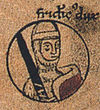 | 1090 son of Frederick I and Agnes of Germany | Judith of Bavaria 1121 2 children Agnes of Saarbrücken c.1132 2 children | 6 April 1147 aged 56 or 57 | ||
| Frederick III Barbarossa 1147–1152 |  | 1122 son of Frederick II and Judith of Bavaria | Adelheid of Vohburg 2 March 1147 Eger no children Beatrice of Burgundy 9 June 1156 Würzburg 12 children | 10 June 1190 aged 67 or 68 | ||
| Frederick IV 1152–1167 |  | 1145 son of Conrad III of Germany and Gertrude von Sulzbach | Gertrude of Bavaria 1166 no children | 19 August 1167 Rome aged 21 or 22 | ||
| Frederick V 1167–1170 | 16 July 1164 Pavia son of Frederick III and Beatrice of Burgundy | unmarried | 28 November 1170 aged 6 | |||
| Frederick VI 1170–1191 |  | February 1167 Modigliana son of Frederick III and Beatrice of Burgundy | unmarried | 20 January 1191 Acre aged 24 | ||
| Conrad II 1191–1196 | 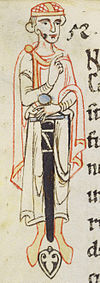 | February or March 1173 son of Frederick III and Beatrice of Burgundy | unmarried | 15 August 1196 Durlach aged 23 | ||
| Philip 1196–1208 | 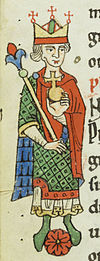 | August 1177 son of Frederick III and Beatrice of Burgundy | Irene Angelina 25 May 1197 4 children | 21 June 1208 Bamberg aged 30 | ||
| Vacancy: 1208-1212 | ||||||
| Frederick VII 1212–1216 | 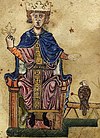 | 26 December 1194 Jesi son of Henry I and Constance of Sicily | Constance of Aragon 15 August 1209 1 child Isabella II of Jerusalem 9 November 1225 2 children Isabella of England 15 July 1235 4 children | 13 December 1250 Torremaggiore aged 55 | ||
| Henry II 1216–1235 |  | 1211 Sicily son of Frederick I and Constance of Aragon | Margaret 29 November 1225 2 children | 12 February 1242 Martirano aged 30 | ||
| Conrad III 1235–1254 |  | 25 April 1228 Andria son of Frederick I and Isabella II of Jerusalem | Elisabeth of Bavaria 1 September 1246 1 child | 21 May 1254 Lavello aged 26 | ||
| Conrad IV the Younger 1254–1268 |  | 25 March 1252 Wolfstein son of Conrad I and Elisabeth of Bavaria | never married | 29 October 1268 Naples aged 16 (executed) | ||
House of Habsburg (1283–1309)
Family tree
Successor states
In the 13th century, the Duchy of Swabia disintegrated into numerous smaller states. Some of the more important immediate successor states were:
|
|
During the following century, several of these states were acquired by the County of Württemberg or the Duchy of Austria, as marked above. In 1803 Bavarian Swabia was annexed by Bavaria and shortly afterwards became part of the Kingdom of Bavaria.
See also
Related Research Articles

The Ottonian dynasty was a Saxon dynasty of German monarchs (919–1024), named after three of its kings and Holy Roman Emperors named Otto, especially its first Emperor Otto I. It is also known as the Saxon dynasty after the family's origin in the German stem duchy of Saxony. The family itself is also sometimes known as the Liudolfings, after its earliest known member Count Liudolf and one of its most common given names. The Ottonian rulers were successors of the Germanic king Conrad I, who was the only Germanic king to rule in East Francia after the Carolingian dynasty and before this dynasty.

The House of Zähringen was a dynasty of Swabian nobility. The family's name derived from Zähringen Castle near Freiburg im Breisgau. The Zähringer in the 12th century used the title of Duke of Zähringen, in compensation for having conceded the title of Duke of Swabia to the Staufer in 1098. The Zähringer were granted the special title of Rector of Burgundy in 1127, and they continued to use both titles until the extinction of the ducal line in 1218.

Henry II, called the Wrangler or the Quarrelsome, a member of the German royal Ottonian dynasty, was Duke of Bavaria from 955 to 976 and again from 985 to 995, as well as Duke of Carinthia from 989 to 995.

Conrad I, called the Younger, was the king of East Francia from 911 to 918. He was the first king not of the Carolingian dynasty, the first to be elected by the nobility and the first to be anointed. He was chosen as the king by the rulers of the East Frankish stem duchies after the death of young King Louis the Child. Ethnically Frankish, prior to this election he had ruled the Duchy of Franconia from 906.
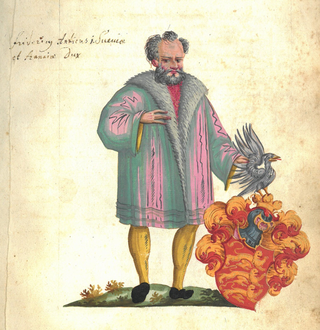
Frederick I before 21 July was Duke of Swabia from 1079 to his death, the first ruler from the House of Hohenstaufen (Staufer).
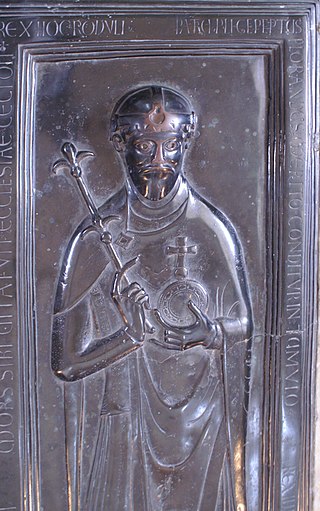
Rudolf of Rheinfelden was Duke of Swabia from 1057 to 1079. Initially a follower of his brother-in-law, the Salian emperor Henry IV, his election as German anti-king in 1077 marked the outbreak of the Great Saxon Revolt and the first phase of open conflict in the Investiture Controversy between Emperor and Papacy. After a series of armed conflicts, Rudolf succumbed to his injuries after his forces defeated Henry's in the Battle on the Elster.

Judith of Bavaria, a member of the Luitpolding dynasty, was Duchess consort of Bavaria from 947 to 955, by her marriage with Duke Henry I. After her husband's death, she acted as regent of Bavaria during the minority of her son Henry the Wrangler in 955-972.

Otto I was the Duke of Swabia from 973 and Duke of Bavaria from 976. He was a member of the Ottonian dynasty, the only son of Duke Liudolf of Swabia and his wife Ida, and thus a grandson of the Emperor Otto I and his Anglo-Saxon wife Eadgyth. His sister Mathilde was the abbess of Essen Abbey.
Berthold II, Duke of Carinthia, also known as Berthold I of Zähringen, was a progenitor of the Swabian House of Zähringen. From 1061 until 1077, he was the Duke of Carinthia and Margrave of Verona.

The Duchy of Swabia was one of the five stem duchies of the medieval German Kingdom. It arose in the 10th century in the southwestern area that had been settled by Alemanni tribes in Late Antiquity.

The War of the Three Henries was a brief rebellion of three German princes, all called Henry, against Emperor Otto II in 976–977, with a final peace imposed in 978.
Herman II was a member of the Conradine dynasty. He was Duke of Swabia from 997 to his death. In 1002, Herman unsuccessfully attempted to become king of Germany.
Henry III, called the Younger, a member of the Luitpolding dynasty, was the first Duke of Carinthia from 976 to 978, Duke of Bavaria from 983 to 985 and again Duke of Carinthia from 985 to 989.
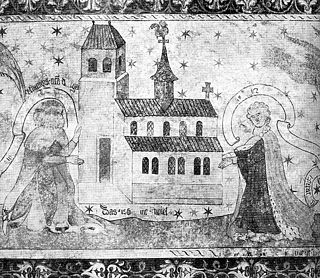
Burchard III, a member of the Hunfriding dynasty, was the count of Thurgau and Zürichgau, perhaps of Rhaetia, and then Duke of Swabia from 954 to his death.
Burchard II was the Hunfriding Duke of Swabia and Count of Raetia. He was the son of Burchard I of Swabia and Liutgard of Saxony.
Berthold II, also known as Berchtold II, was the Duke of Swabia from 1092 to 1098. After he conceded the Duchy of Swabia to the Staufer in 1098, the title of "Duke of Zähringen" was created for him, in use from c. 1100 and continued by his successors until 1218.
The Conradines or Conradiner were a dynasty of Franconian counts and dukes in the 8th to 11th Century, named after Duke Conrad the Elder and his son King Conrad I of Germany.

Otto I, traditionally known as Otto the Great, or Otto of Saxony, was East Frankish king from 936 and Holy Roman Emperor from 962 until his death in 973. He was the eldest son of Henry the Fowler and Matilda of Ringelheim.
References
Text is available under the CC BY-SA 4.0 license; additional terms may apply.
Images, videos and audio are available under their respective licenses.
